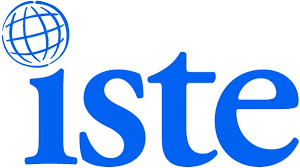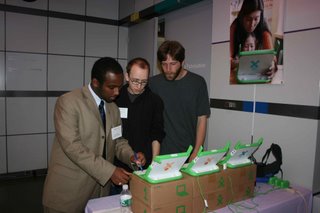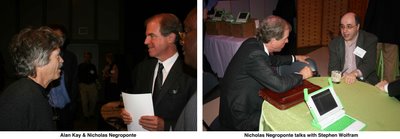Bits for the poorWesley Fryer’s recent blog,
A digital playground of dreams?, makes the case for play and then discusses what would/should be in a digital playground. I think the logic is that if real playgrounds are good for kids, so are digital playgrounds.
OK, so far so good. But then the article assumes that software (at least software for kids) should be free. Why is
free the criteria?
Why is software so devalued that a growing number of people believe it should be free?
Balls and playground equipment are not free. Hardware is not free. Spelling books and standardized tests are not free.
Why not have free teachers? You could all work voluntarily.
Is the quest for free software rooted in the low self-image of educators? Why should teachers depend on charity? This emphasis on “free-ness” seems sad, needy and symptomatic of powerlessness to me.
It’s one thing to be a good bargain hunter on behalf of your students. I too have learned to wait around conference exhibits waiting for vendors to give me books and PE equipment they don’t want to ship back to the office. However, that seems qualitatively different from the lonely teacher I see shuffling out of the half demolished exhibit hall carrying armloads of free bags full of other bags. Should educators be reduced to bag ladies? Is software the new free ballpoint pen?
There’s no such thing as free software Software development is paid for by either of the following:
- Consumers/customers
- Government agencies via grants to research and development institutions in higher education or the K-12 bureaucracy (for example, The National Science Foundation or the military)
- Universities
- For-profit companies spending investor funds and tax credits to make charitable contributions to education
- A programmer working alone or with his/her friends who want to share their software
In all, but the last (and least common) case, the free software you are using cost you as a taxpayer or someone else, as a stockholder. You just didn’t use a credit card at Best Buy to pay for it.
It is certainly the case that educators embraced Microsoft Office as what kids should do with computers. I've been on-the-record against children playing Donald Trump dress-up in computer labs for decades. For Pete’s sake you can satisfy ALL of the ISTE standards with Office alone. The new appeals for creativity and innovation are mere lip service.
Even with productivity tools (what an awful term for children) you could do with fewer features. Such streamlined design would reduce costs and make software more usable and developmentally appropriate for children. This does not mean for one instant that I believe that preschoolers are incapable of using Office. What I do mean is that the false complexity implied by too many menus, submenus and dialog boxes ensures that the teacher’s focus is on features and the software’s peculiarities rather than on its creative use.
Don’t believe me? Look at the number of district tech plans that make using scroll bars a nine-year scope and sequence? How many 700-page books are published to teach you to use a web browser or word processor?
I love inexpensive software, but I'm weary of digital handouts. Some of the most ingenious pieces of software I use regularly are shareware. I pay a reasonable fee to a clever person who provided me with a great service.
The fact that districts, states and national governments surrender too much public treasure to Microsoft is not an argument against hardworking software designers and programmers earning a living. Some countries (more so than in the USA) often subsidize the development of software and materials for schools that compete directly with the open market. You'd be hard pressed to identify three such products that were worth what the government invested.
You get what you pay for Sure, it’s relatively easy for programmers to knock-off free copies of existing software – paint programs, word processors and even operating systems fall into this category. Occasionally some of these programs are even better than the commercial originals. However, the hard expensive work of invention
has already occurred.
It’s expensive and incredibly hard to invent (after all software design is a form of invention) productive contexts for learning; what Seymour Papert called microworlds. Microworlds facilitate creativity, problem solving, divergent thinking, debugging and encounters with powerful ideas. It takes educational experts and gifted software designers to create such environments for children. If such software packages are developed, their sales potential is extremely limited since their market is almost exclusively K-12 schools. The same customers that expect software to be free.
Have you noticed that the educational software industry is nearly dead? This is one reason why I organized
The Constructivist Consortium. The Consortium brings together publishers of creative open-ended learning materials so they may stand out in a sea of “smart” furniture, multiple-choice clickers and testing software while giving voice to the fantastic educators who work every day to provide constructive creative learning opportunities for their students.
Even in the hey-day of Reader Rabbit and Math Blaster, the school market was just viewed as a way of lending legitimacy to dubious software packages for sale at the local Wal-Mart. Schools never bought much of the software, but the publishers were able to point to classroom use as a way of convincing parents that the software would “teach” their children
something.
Small creative educational software companies, such as
Logo Computer Systems, Inc., (LCSI) now in its 26th year of creating powerful software environments for learning, have worked tirelessly to make high-quality products available to American students, but they are no match for the white board pitch-men and the integrated “learning” systems companies.
Many of you may not remember this, but it was LCSI, a 100% educational software company, that invented the site license with the release of LogoWriter in 1985. Such brilliant software grew with the learner and could be used creatively for years cost very little. However, its developers deserved to feed their families and invest in the development of future software like LEGO TC Logo and
MicroWorlds EX.
It was also LogoWriter and later, MicroWorlds, that fueled the education renaissance in Costa Rica. (see articles
here and
here) Teachers began to see themselves and their students’ potentials through fresh eyes and
not only were Costa Rican schools improved, but the nation’s economic fortunes rose as well. The fatal flaw in the $100 laptop As the person who led professional development in the world’s first laptop schools back in 1990, I have spent nearly two decades as an unabashed evangelist for every student owning a personal portable full-function computer.
I am an unapologetic supporter of the
$100 Laptop initiative and refuse to be drawn into petty squabbles over hardware features, price-point or whether or not the project honors teachers sufficiently. I believe that putting millions of PCs in the hands of children
does hold the potential to change the world and may offer the first opportunity in generations to rethink teaching and learning.
That said, my greatest disappointment with the One Laptop Per Child project is that the principles involved do not think that it is difficult to develop high-quality intellectually expansive software for children and they refuse to pay others to develop it. Without such software, the potential of the $100 laptop will be severely crippled. Children will be able to consume information and chat, just like American kids. They just won’t be able to create or be the mathematicians, scientists, composers, engineers, filmmakers or computer scientists they could be if the “smart” adults behind the development of the hardware had more respect for software development.
A great robust developmentally appropriate programming environment, like MicroWorlds EX, would be a welcome addition to each $100 laptop. However, Redhat employees cannot develop such software during their lunch break. It requires expertise and insight into learning that they (and even MIT students) lack. It’s too bad since such an environment would add sustainability to the creative and intellectual use of the device and allow students to create software themselves.
I fear that if fewer children have experience programming computers and expressing themselves symbolically, then software will cases to have any value at all. Wes Fryer’s blog paraphrases Alan Kay about “inventing the future,” but the actual quote is “The best way to predict the future is by inventing it.” I’m confident that Dr. Kay believes that one way of inventing the future is by constructing knowledge and new tools via computer programming. The future does not look very bright if as
Seymour Papert pointed out, we deprive children of the opportunity to understand and control the technology so central to their lives.
Footnote #1
Why not call software an invention? People don’t expect inventions to be free?
Labels: Gary Stager, OLPC, software, speedofcreativity.org, wes fryer



